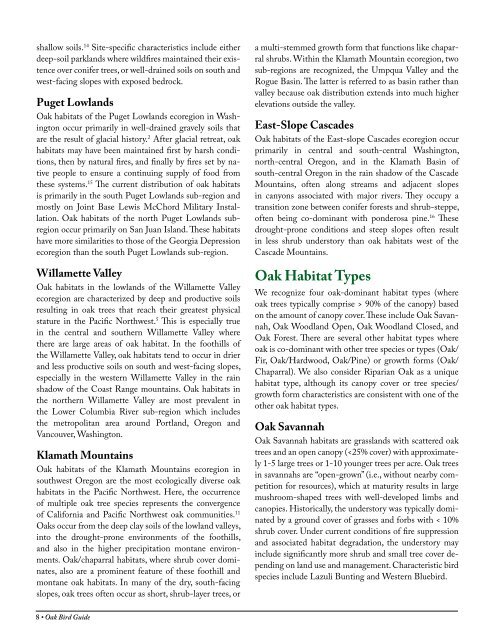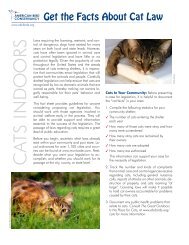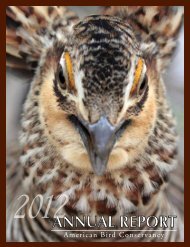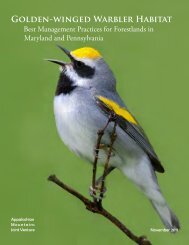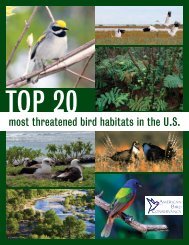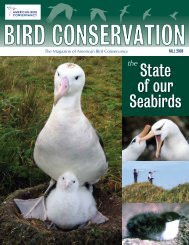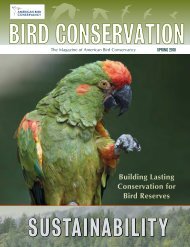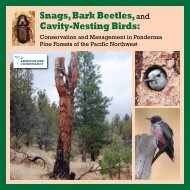Oak Ecosystems in the Pacific Northwest - American Bird Conservancy
Oak Ecosystems in the Pacific Northwest - American Bird Conservancy
Oak Ecosystems in the Pacific Northwest - American Bird Conservancy
You also want an ePaper? Increase the reach of your titles
YUMPU automatically turns print PDFs into web optimized ePapers that Google loves.
shallow soils. 14 Site-specific characteristics <strong>in</strong>clude ei<strong>the</strong>r<br />
deep-soil parklands where wildfires ma<strong>in</strong>ta<strong>in</strong>ed <strong>the</strong>ir existence<br />
over conifer trees, or well-dra<strong>in</strong>ed soils on south and<br />
west-fac<strong>in</strong>g slopes with exposed bedrock.<br />
Puget Lowlands<br />
<strong>Oak</strong> habitats of <strong>the</strong> Puget Lowlands ecoregion <strong>in</strong> Wash<strong>in</strong>gton<br />
occur primarily <strong>in</strong> well-dra<strong>in</strong>ed gravely soils that<br />
are <strong>the</strong> result of glacial history. 2 After glacial retreat, oak<br />
habitats may have been ma<strong>in</strong>ta<strong>in</strong>ed first by harsh conditions,<br />
<strong>the</strong>n by natural fires, and f<strong>in</strong>ally by fires set by native<br />
people to ensure a cont<strong>in</strong>u<strong>in</strong>g supply of food from<br />
<strong>the</strong>se systems. 15 The current distribution of oak habitats<br />
is primarily <strong>in</strong> <strong>the</strong> south Puget Lowlands sub-region and<br />
mostly on Jo<strong>in</strong>t Base Lewis McChord Military Installation.<br />
<strong>Oak</strong> habitats of <strong>the</strong> north Puget Lowlands subregion<br />
occur primarily on San Juan Island. These habitats<br />
have more similarities to those of <strong>the</strong> Georgia Depression<br />
ecoregion than <strong>the</strong> south Puget Lowlands sub-region.<br />
Willamette Valley<br />
<strong>Oak</strong> habitats <strong>in</strong> <strong>the</strong> lowlands of <strong>the</strong> Willamette Valley<br />
ecoregion are characterized by deep and productive soils<br />
result<strong>in</strong>g <strong>in</strong> oak trees that reach <strong>the</strong>ir greatest physical<br />
stature <strong>in</strong> <strong>the</strong> <strong>Pacific</strong> <strong>Northwest</strong>. 5 This is especially true<br />
<strong>in</strong> <strong>the</strong> central and sou<strong>the</strong>rn Willamette Valley where<br />
<strong>the</strong>re are large areas of oak habitat. In <strong>the</strong> foothills of<br />
<strong>the</strong> Willamette Valley, oak habitats tend to occur <strong>in</strong> drier<br />
and less productive soils on south and west-fac<strong>in</strong>g slopes,<br />
especially <strong>in</strong> <strong>the</strong> western Willamette Valley <strong>in</strong> <strong>the</strong> ra<strong>in</strong><br />
shadow of <strong>the</strong> Coast Range mounta<strong>in</strong>s. <strong>Oak</strong> habitats <strong>in</strong><br />
<strong>the</strong> nor<strong>the</strong>rn Willamette Valley are most prevalent <strong>in</strong><br />
<strong>the</strong> Lower Columbia River sub-region which <strong>in</strong>cludes<br />
<strong>the</strong> metropolitan area around Portland, Oregon and<br />
Vancouver, Wash<strong>in</strong>gton.<br />
Klamath Mounta<strong>in</strong>s<br />
<strong>Oak</strong> habitats of <strong>the</strong> Klamath Mounta<strong>in</strong>s ecoregion <strong>in</strong><br />
southwest Oregon are <strong>the</strong> most ecologically diverse oak<br />
habitats <strong>in</strong> <strong>the</strong> <strong>Pacific</strong> <strong>Northwest</strong>. Here, <strong>the</strong> occurrence<br />
of multiple oak tree species represents <strong>the</strong> convergence<br />
of California and <strong>Pacific</strong> <strong>Northwest</strong> oak communities. 11<br />
<strong>Oak</strong>s occur from <strong>the</strong> deep clay soils of <strong>the</strong> lowland valleys,<br />
<strong>in</strong>to <strong>the</strong> drought-prone environments of <strong>the</strong> foothills,<br />
and also <strong>in</strong> <strong>the</strong> higher precipitation montane environments.<br />
<strong>Oak</strong>/chaparral habitats, where shrub cover dom<strong>in</strong>ates,<br />
also are a prom<strong>in</strong>ent feature of <strong>the</strong>se foothill and<br />
montane oak habitats. In many of <strong>the</strong> dry, south-fac<strong>in</strong>g<br />
slopes, oak trees often occur as short, shrub-layer trees, or<br />
a multi-stemmed growth form that functions like chaparral<br />
shrubs. With<strong>in</strong> <strong>the</strong> Klamath Mounta<strong>in</strong> ecoregion, two<br />
sub-regions are recognized, <strong>the</strong> Umpqua Valley and <strong>the</strong><br />
Rogue Bas<strong>in</strong>. The latter is referred to as bas<strong>in</strong> ra<strong>the</strong>r than<br />
valley because oak distribution extends <strong>in</strong>to much higher<br />
elevations outside <strong>the</strong> valley.<br />
East-Slope Cascades<br />
<strong>Oak</strong> habitats of <strong>the</strong> East-slope Cascades ecoregion occur<br />
primarily <strong>in</strong> central and south-central Wash<strong>in</strong>gton,<br />
north-central Oregon, and <strong>in</strong> <strong>the</strong> Klamath Bas<strong>in</strong> of<br />
south-central Oregon <strong>in</strong> <strong>the</strong> ra<strong>in</strong> shadow of <strong>the</strong> Cascade<br />
Mounta<strong>in</strong>s, often along streams and adjacent slopes<br />
<strong>in</strong> canyons associated with major rivers. They occupy a<br />
transition zone between conifer forests and shrub-steppe,<br />
often be<strong>in</strong>g co-dom<strong>in</strong>ant with ponderosa p<strong>in</strong>e. 16 These<br />
drought-prone conditions and steep slopes often result<br />
<strong>in</strong> less shrub understory than oak habitats west of <strong>the</strong><br />
Cascade Mounta<strong>in</strong>s.<br />
<strong>Oak</strong> Habitat Types<br />
We recognize four oak-dom<strong>in</strong>ant habitat types (where<br />
oak trees typically comprise > 90% of <strong>the</strong> canopy) based<br />
on <strong>the</strong> amount of canopy cover. These <strong>in</strong>clude <strong>Oak</strong> Savannah,<br />
<strong>Oak</strong> Woodland Open, <strong>Oak</strong> Woodland Closed, and<br />
<strong>Oak</strong> Forest. There are several o<strong>the</strong>r habitat types where<br />
oak is co-dom<strong>in</strong>ant with o<strong>the</strong>r tree species or types (<strong>Oak</strong>/<br />
Fir, <strong>Oak</strong>/Hardwood, <strong>Oak</strong>/P<strong>in</strong>e) or growth forms (<strong>Oak</strong>/<br />
Chaparral). We also consider Riparian <strong>Oak</strong> as a unique<br />
habitat type, although its canopy cover or tree species/<br />
growth form characteristics are consistent with one of <strong>the</strong><br />
o<strong>the</strong>r oak habitat types.<br />
<strong>Oak</strong> Savannah<br />
<strong>Oak</strong> Savannah habitats are grasslands with scattered oak<br />
trees and an open canopy (


